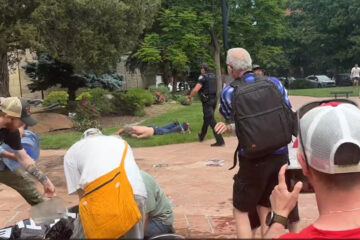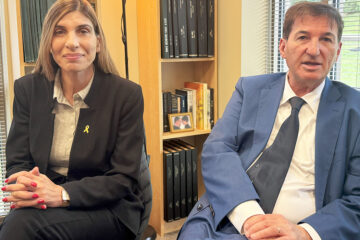David Urbansky, Civil War Hero
Medal of Honor recipient from Piqua recognized again for his valor during the Civil War
Story and Photos by Maxwell Nathan
Special To The Dayton Jewish Observer, February 2001
 Fifty people from Central and Western Ohio gathered in a Cincinnati Jewish cemetery in December to pay their respects to a man who died 104 years ago. They came to dedicate a special monument to the Civil War hero from Piqua.
Fifty people from Central and Western Ohio gathered in a Cincinnati Jewish cemetery in December to pay their respects to a man who died 104 years ago. They came to dedicate a special monument to the Civil War hero from Piqua.
David Urbansky was a recipient of the Medal of Honor, bestowed by the U.S. Congress, for gallantry at two battles among the 15 or more major fighting engagements he was in throughout the war.
He was like many of the early Jewish settlers in the small towns and cities of the Miami Valley. He had a clothing store and it was in Piqua. But he came there with his Jewish bride and fresh citizenship papers when he was already a hero of the just-ended war.
Urbansky was the only known Jew and one of only 18 of Ohio’s 310,364 Union soldiers in the Civil War to receive the Medal of Honor, the nation’s highest award. He was one of six Jewish soldiers nationally to be awarded the medal in that war.
As a teenager, he immigrated to America with his parents in 1857 from Lautenburg, in the Kingdom of Prussia (now a part of Poland). He was listed as a cabinet maker. After several years in New York state, Urbansky moved to Columbus, Ohio to start a mercantile business.
When the Civil War erupted. Urbansky promptly enlisted with the Columbus B, 58th Ohio Volunteers. Throughout the war he served under Generals Grant and Sherman, among others. His highest rank was corporal.
His Medal of Honor citation specifies “Gallantry in Action” at two of this many fighting engagements: the 1862 Battle of Shiloh, Tenn. (where both sides suffered combined casualties of nearly 24,000), and the seven month siege of Vicksburg, Miss.
During the first assault of Vicksburg, the charge ended with Urbansky’s commanding officer lying seriously wounded out in the “no-man’s” land between the opposing forces.
The 5-foot, 3-inch Urbansky went out alone despite fierce enemy fire and carried his officer back to safety. The officer later recovered through prompt medical treatment.
Urbansky’s Medal of Honor is now on display at the National Jewish Archives at Hebrew Union College- Jewish Institute of Religion in Cincinnati.
After Urbansky was discharged in 1865 at war’s end, he quickly obtained his U.S. citizenship papers in Columbus. He then was married near Schenectady, N.Y. in a Jewish wedding to Rachel Henry. His ketubah (marriage contract) gives his Hebrew name as translating into Aaron David Urbansky.
The young couple then moved to Piqua where he established his clothing business. They had 12 children. Following a long illness, he died in January 1897.
 His funeral, held at this family’s residence in Piqua, was conducted by Reform Rabbi David Phillipson, spiritual leader of K.K. Bene Israel in Cincinnati, now Rockdale Temple.
His funeral, held at this family’s residence in Piqua, was conducted by Reform Rabbi David Phillipson, spiritual leader of K.K. Bene Israel in Cincinnati, now Rockdale Temple.
The Grand Army of the Republic (Union veteran’s organization) attended the funeral in a body to honor this well-regarded Jewish businessman who had received the nation’s highest military award. Also on hand was the Piqua Masonic Lodge that attended in a body to honor one of its own.
Urbansky was originally buried in Piqua’s Cedar Hill Jewish Cemetery according to the extensive obituaries in the Piqua Daily Call newspaper of January 1897, and according to the government records.
Some time following Urbansky’s passing, the family moved to Cincinnati. When his widow, Rachel, died in 1914, the children had their father’s remains moved to Cincinnati and placed next to her in what is now the United Jewish Cemeteries at 3400 Montgomery Road.
The children legally changed their name to “Urban.” Adjacent are gravestones of eight of their 12 children.
The ceremony on Dec. 10, 2000 in the Cincinnati cemetery was to dedicate a new, gold-lettered stone the U.S. government has just provided to mark Urbansky’s present grave as that of a Civil War Medal of Honor recipient.
At the service, an 11-man squad attired in Civil War military uniforms served as a guard of honor leading the procession to the grave. They were from the 6th Ohio Volunteer Infantry Reenactment Group. With period rifles, they fired a 21-gun salute and a bugler sounded taps to conclude the service.
Rabbi Mark. N. Goldman, senior rabbi of the Rockdale Temple and one of Rabbi Phillipson’s successors, led the Jewish prayers on dedicating a gravestone. Edward G. Marks, president or the Cincinnati United Jewish Cemeteries Board, presided over the ceremony.
David Urban of Springfield, a great-great nephew of Urbansky, participated. He said he had learned of his relative’s military exploits only in recent years.
A moving tribute to the Medal of Honor recipient was given by Raymond Albert of Columbus, a volunteer and member of the Medal of Honor Historical Society.
He had identified Urbansky’s grave in the cemetery under the family headstone of “Urban.”
This was the 16th such grave he had discovered and the first in a Jewish cemetery in his 16 years of such research.
Albert said Urbansky volunteered then risked his life to perform acts of outstanding bravery in the presence of the enemy beyond the call of duty even before he could become a citizen of this country.
 Eileen Litchfield, of Greenville, president of Temple Anshe Emeth, the Reform Jewish congregation in Piqua, was among those who attended the dedication.
Eileen Litchfield, of Greenville, president of Temple Anshe Emeth, the Reform Jewish congregation in Piqua, was among those who attended the dedication.
A number of people at the ceremony had sought Urbansky’s grave for three or more years, but they had been frustrated by name variations.
Urbansky served in the army, received the Medal of Honor and certificate of citizenship under the spelling “Orbansky.” He married as Urbansky and continued under that name until his death in 1897. Today he rests under a headstone of “Urban.”
Several older Cincinnatians at the Urbansky ceremony said the youngest of Rachel and David’s 12 children, Miriam Urban, had been on the faculty of the University of Cincinnati many years ago. Miriam, who was 8 years old when she lost her father, died in 1977. She is the child buried nearest to her mother.






